Coyotes and Their Howling Success
You walk outside, perhaps to look at the stars just coming out or to take your dog for a quick walk. It’s a calm, peaceful night, not a sound, when all a sudden – you hear a wild howl! A coyote!
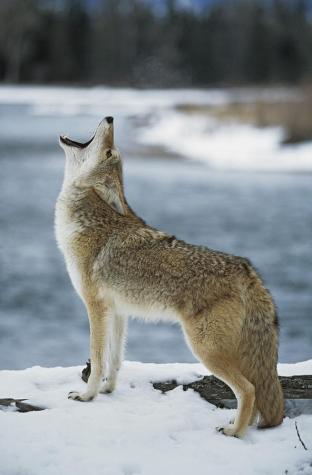 You think, “Coyotes? Near here? I’ve never even seen them! I wonder if they are dangerous?” Perhaps you even live in a city, or think that coyotes are just in the western prairie states, the traditional home of the coyote. Believe it or not, if you live anywhere in the United States or Canada, there are almost definitely coyotes by you; and lots of them!
You think, “Coyotes? Near here? I’ve never even seen them! I wonder if they are dangerous?” Perhaps you even live in a city, or think that coyotes are just in the western prairie states, the traditional home of the coyote. Believe it or not, if you live anywhere in the United States or Canada, there are almost definitely coyotes by you; and lots of them!
Coyotes in the state of New York have been seen in Manhattan and seem to be moving toward Long Island. There are coyotes on Lake Shore Drive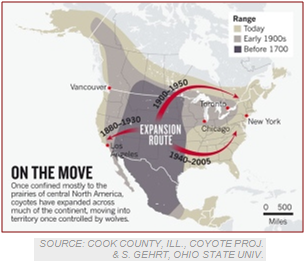 in Chicago and residents of Seal Beach California are dealing with a large coyote population. Coyotes didn’t used to be so widespread or have such common interactions with people; how did this population boom come to be? About two hundred years ago, coyotes began a long and widespread migration. Spreading from their original territory in the Western Prairie and Rocky Mountain States as well as Mexico, they moved east, west, north, and south – everywhere! They were not all content to keep their life in the country; many coyotes like those mentioned above have chosen to become city dwellers. These wily critters have been seen waiting for red lights to cross the street, crossing four lanes of traffic, and using drainage ditches as dens for their pups. From the heart of Washington D.C. to the heart of Death Valley, these amazing survivors are flourishing. What is the secret to their howling success and how do coyotes affect us and the environment?
in Chicago and residents of Seal Beach California are dealing with a large coyote population. Coyotes didn’t used to be so widespread or have such common interactions with people; how did this population boom come to be? About two hundred years ago, coyotes began a long and widespread migration. Spreading from their original territory in the Western Prairie and Rocky Mountain States as well as Mexico, they moved east, west, north, and south – everywhere! They were not all content to keep their life in the country; many coyotes like those mentioned above have chosen to become city dwellers. These wily critters have been seen waiting for red lights to cross the street, crossing four lanes of traffic, and using drainage ditches as dens for their pups. From the heart of Washington D.C. to the heart of Death Valley, these amazing survivors are flourishing. What is the secret to their howling success and how do coyotes affect us and the environment?
The coyotes’ golden ticket came when the early settlers started rolling west in their covered wagons. As they went, they started farms and flocks. These early settlers believed that the wolves, mountain lions, and bears that roamed the wilds at that time were serious threats to their herds, so they did their best to exterminate as many of these creatures as they could. As soon as all these competitors were out of the way, the coyote became the “top dog”. Coyotes are what scientists call opportunists, meaning they are immensely adaptable in their diets. While rode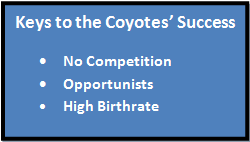 nts were the traditional food source of the early coyotes, as they spread across North America no longer hindered by competitors, they easily adapted to new foods, now eating everything from grasshoppers and lizards to young and sick deer. Once coyotes became top of the food chain, people began to pay more attention to them and worried about the safety of their livestock and pets. Many people tried to do what the early western settlers had done to the wolves, mountain lions, and bears, but it didn’t work. Why? When coyotes are stressed, they have larger litters and begin having them at an earlier age. This leads to the coyote population actually growing instead of shrinking when people try to exterminate them.
nts were the traditional food source of the early coyotes, as they spread across North America no longer hindered by competitors, they easily adapted to new foods, now eating everything from grasshoppers and lizards to young and sick deer. Once coyotes became top of the food chain, people began to pay more attention to them and worried about the safety of their livestock and pets. Many people tried to do what the early western settlers had done to the wolves, mountain lions, and bears, but it didn’t work. Why? When coyotes are stressed, they have larger litters and begin having them at an earlier age. This leads to the coyote population actually growing instead of shrinking when people try to exterminate them.
Coyotes and People
With so many coyotes as the new dogs in town, how we get along with them is becoming more and more relevant. Coyotes are rather shy of humans, and even when they can be seen in cities surrounded by people they almost never approach or even pay any attention to humans but mind their own business and go on their way very unobtrusively. However, coyotes are just like all wild animals and their behavior can be altered.
Don’t Feed a Coyote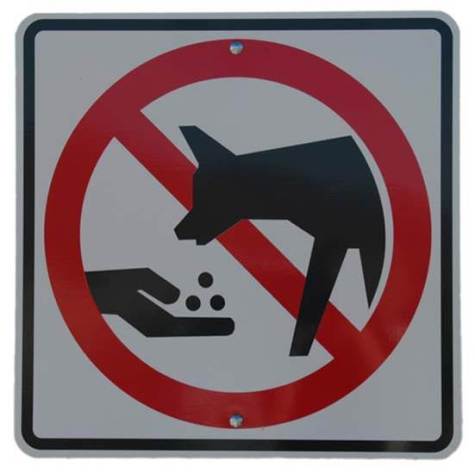
One of the biggest causes for changes in the rather shy behavior of coyotes is being fed by humans. Many of the rare times a coyote bites a human are because the person was feeding the coyote or the coyote had lost its fear of people by being intentionally or non-intentionally fed.
Don’t Run From a Coyote
If a coyote has lost its fear of people and approaches a person threateningly, the person should not run because coyotes will follow their hunting instincts and give chase. If threatened by a coyote, a person should shout loudly and throw things at the coyote, convincing him that he doesn’t want to mess with this big bad human.
Don’t let pets run loose
Humans seldom have to be deeply concerned about attacks from coyotes on themselves since they are very rare; there were only 159 bites by coyotes from 1960-2006. However, if there are coyotes near you, you should keep an eye on your pets. Don’t let small pets outside alone at night or around dawn and dusk when coyotes aren’t as afraid to show themselves. People that live in certain areas that have a bigger, more competitive, and generally more brazen coyote population should be more cautious, like those in Seal Beach California were many pets have been attacked. Also, if you feed your pet outside, make sure his or her food is completely cleaned up because pet food, as well as easily reachable garbage, will attract coyotes. Remember, coyotes will eat almost anything.
Coyotes and the Environment
There are relatively few studies so far on the impact that coyotes have on the environment, but researchers generally agree that coyotes are helping in some small way to fill the ecological niche caused by the absence of wolves. Though they by no means fill the niche completely, and fill it to various degrees depending upon what part of the country they live in, many scientist are excited about the way coyotes are helping to maintain rodent populations and Canada geese as well as other critters that would otherwise be growing unchecked and causing imbalances in the ecosystem.
Past, Present, and Future
Coyotes are masters of survival. These cunning and stunning creatures are an amazing example of God’s incredible engineering to make these critters master adapters to live in their ever changing environments from the wilderness to the city. Just as the Native Americans learned to get along with and appreciate these symbols of the American West and the American never-say-die spirit – they even included them in many of their legends – we should try to get along with and respect this wildlife living among us, because coyotes are here to stay!

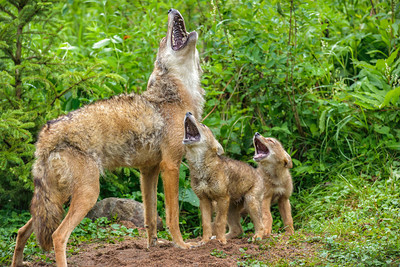




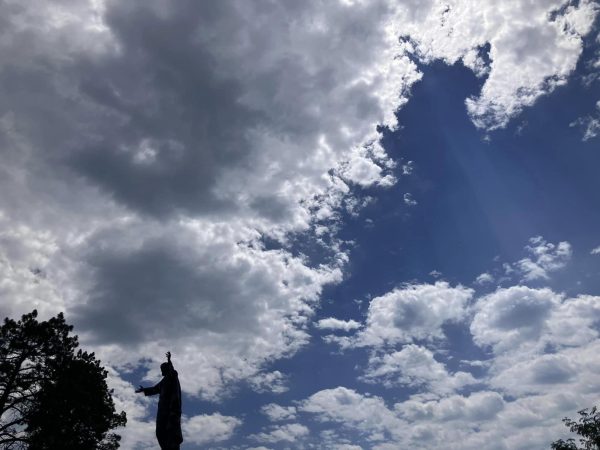



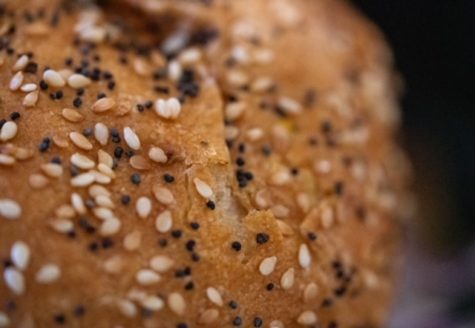


Gracie Feltes • Nov 13, 2014 at 2:26 pm
Amazing article, Marley! I never knew all this!
Stephen T. • Nov 7, 2014 at 1:54 pm
Interesting! I never knew that. I always thought that foxes were the top dog in cities.
Although I have never seen a coyote, I have heard them a few times.